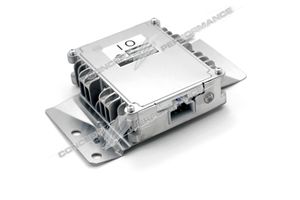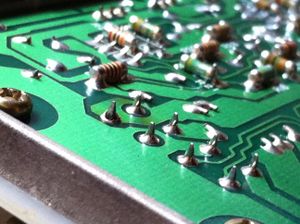Fuel Pump Control Unit
The Fuel Pump Control Unit or FPCU is a device which controls the voltage supplied to the fuel pump, based on several running conditions monitored by the ECU.

Versions
There are two versions of the FPCU.
- Non-Turbo (All years)
- Twin Turbo (All years)
Function
The FPCU receives a signal from the ECU demanding fuel pump operation at one of two (or three, in the TT) speeds. The speed is determined by various conditions operating conditions. The ECU determines the required speed and sends a signal to the FPCU, which transforms it to a voltage which is then sent to the fuel pump itself.
| Condition |
Supplied Voltage | |
| |
Non-Turbo |
Twin Turbo |
|
Battery Voltage. |
Battery Voltage. |
|
Battery Voltage. |
Approx. 7V. |
|
Approx. 8V. |
Approx. 6V. |
On TT Swaps
When converting your NA to a TT, there are two optional routes one must take in regards to fuel pump control.
- Install a TT pump, but continue to use an NA FPCU. You must also socket the ECU and install an EPROM which is programmed for a swap, as an NA ECU doesn't have the fuel/ignition maps for forced induction, and a TT ECU would try to control the three-speed FPCU which doesn't exist/doesn't have wiring. A TT ECU also tries to control wastegate actuators and the two-speed cooling fan, both of which don't exist on NA models.
- The NA FPCU will run the TT FPCU at higher voltage than a TT FPCU would under the same conditions, but most agree this is without ill-effects on the fuel pump, and any excess fuel is dealt with by the fuel pressure regulator.
- Install a TT pump, TT FPCU, TT ECU, and TT body harness (or run a wire from the ECU to the FPCU harness to supply voltage for the third speed).
In general, you should not install a TT ECU in an NA without running the wiring for it and using a TT FPCU, as a TT ECU will try to utilize the third fuel pump speed, which doesn't exist. To a TT FPCU, "speed 1" is 6V, "speed 2" is 7V, and "speed 3" is battery voltage. To an NA FPCU, "speed 1" is 8V, "speed 2" is battery voltage, and "speed 3" is "who are you? what? where am I?"
Failure
For some reason, and despite being a non-mechanical part, the FPCU is quite prone to failure. Over time, internal components either outright fail (often showing visible damage and deformity), or solder joints corrode and rot away. This will lead to a condition in which the ECU is turning the fuel pump relay on and sending a speed signal to the FPCU, but the FPCU either isn't receiving the signal or isn't transforming it into a voltage, due to a broken connection or failed component.
Some possible causes could be:
- Electrolysis, corrosion due to fuel tank-adjacent location.
- Vibration and harshness due to solid metal mounting points.
- Poor quality of solder and/or components.
At $345+, they can be quite expensive to replace, but are usually easily repairable. In most cases, the solder on a single solder joint erodes and the pin or component becomes disconnected from the circuit. Simply clean the area with a toothbrush (don't brush your teeth with it, lol), and reflow the solder.
If a component fails, the component must be replaced. There are four transistors mounted to the sides of the FPCU casing which tend to fail. They can be replaced with off-the-shelf parts by anyone who knows how to solder and de-solder.
Bypassing
You can bypass the FPCU as a temporary solution to get you home if it fails while you're out and about (as it usually does), or to diagnose the FPCU as the root of a non-starting/poor-running condition. The FPCU changes voltage by limiting the ground-side of the signal, so bypassing the FPCU simply requires a direct ground connection to the line which would otherwise be limited, supplying battery voltage to the FPCU under all conditions.
Please note that while many owners have driven on their cars for as long as a year with the FPCU bypassed, it should be done as a temporary solution, as this can put excess strain on the fuel pump and fuel pressure regulator.
As the FPCU wiring is slightly different between the 2+2 and 2-seater, there are two general ways to perform the bypass. See their respective articles below.
Main Article: FPCU Bypass (2-Seater)
Main Article: FPCU Bypass (2+2)
